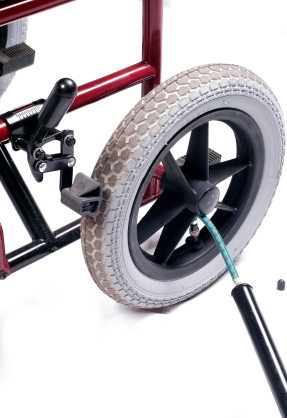Maintaining Your Manual Wheelchair is Easy!

Good maintenance is crucial in order to ensure that your manual wheelchair continues to work properly. Most issues that will arise are not terribly complicated, and the average user - or a spouse, housemate, or caregiver - should have no problem keeping up with the necessary tasks required to keep your wheelchair in top shape. Simply follow these simple guidelines for routine maintenance, and you can extend the life of your wheelchair by years!
Get The Right Tools For The Job
First things first, there's a few tools you'll need to do maintenance on your manual wheelchair. Most of these items can be easily found at a local hardware or department store for a minimal cost, so assembling what you need to get the job done isn't difficult to find or overly expensive. It's also a good idea to invest in a small bag or lightweight toolbox that can store all of the recommended items and be carried with you for when you're out of your home and need to make a quick repair.
An adjustable wrench.
Flat head and Phillips head screwdrivers.
A spoke wrench.
A tire repair kit.
A set of Allen wrenches. Wheelchairs with European parts often use metric measurements, so a set marked for both metric and English units is a good investment.
Some industrial lubricant. WD-40 works just fine for most purposes, though you may want a tube of gel-based lubricant that can be used for more targeted applications.
A bicycle tire pump.
The Basic Maintenance Routine
Some components require regular attention to ensure good daily operation. Here's the most basic things you need to do to keep your wheelchair in good working condition.
At least once a week, wipe down the frame of your wheelchair with a clean, slightly dampened cloth. A little bit of car wax on the frame will also protect it from cosmetic damage and make it easier to keep clean.
Once a month, check for loose nuts and bolts. If a nut or bolt needs to be replaced, make sure you replace it with a part of identical size and strength, and that the threading of the new part matches that of the one you remove. Most bolts are labeled with a number that signifies its strength rating, and you'll want to match or exceed that number when you replace them - remember, a higher number mean a stronger part.
If your manual wheelchair folds up when not in use, make sure it folds and unfolds smoothly and easily. The folding joints need to be lubricated once a year on average, and may need treatment more often than that if you live in a region where high humidity is commonplace. Any pivot point on the wheelchair should also be lubricated, such as where the wheels and casters turn. Don't try to lubricate the ball bearings on your wheelchair - these are sealed for long-term durability, and it's best to have a certified technician service your bearings. Your wheelchair manufacturer can direct you to a qualified specialist in your area who can do this for you.
Check your wheelchair's frame for cracks or weak points monthly. The cross-brace and caster housing are commonly affected by stress cracks due to frequent use. Sometimes a simple welding job can repair such a crack, but from time to time you may need to replace your entire frame. Letting stress cracks go unrepaired can result in a serious injury to the user, so don't let this slip by.
Your axles, wheels, and tires also need regular attention. Many wheelchairs utilize quick-release axles that slide and lock, or are threaded so as to turn like a screw. In either case, the axle should be turning or sliding easily and smoothly and latching properly when inserted. If you hear squeaking or encounter binding and resistance when replacing the axles, try lubricating them, and then reinsert them. If this doesn't solve the problem, you need to contact a technician. The axles, axle housing, and bearings should be wiped clean of debris on a weekly basis with a dry cloth treated with just a little bit of oil.
On a monthly basis, you should check your wheel alignment. Get on a gentle incline and let the wheelchair coast in a straight line - if it pulls to one side or the other without you touching the wheels, your alignment is off. Loose or damaged spokes may also cause this issue. Consult a qualified technician for an alignment adjustment; local bike shops can also often service wheelchair wheels. Check for bent or broken spokes and damaged rims on a weekly basis!
While some wheelchairs use flat free tires for better long term performance, pneumatic (or inflatable) tires are still quite common. Many tire patch kits have tools and patches that can be used to repair a tire tube, which is why we recommend keeping with you - especially if you're an active user outside of your home. Also, to avoid difficult maneuvering and excessive tire wear, make sure your tires are inflated to the proper pressure - the recommended PSI is usually printed on the exterior of the tire, as well as in your owner's manual. Though we recommend using a handheld PSI gauge to determine the proper fill level of your wheelchair tires, one easy test to determine if you have enough air in your tires is to pinch the outer tire walls - they should be firm to the touch, with very little (if any) slack. If your tire tread looks worn, cracked, or loose, or the walls of the tire bulge visibly when you fill them with air, it's time for a replacement.
Finally, check your wheel locks every day and make sure they are securely fastened to the wheelchair's frame and hold the tires firmly when engaged. If they touch the tires while disengaged, this will cause undue wear during use; if they don't clamp firmly when activated, you'll have trouble braking, which could cause a bad accident.
Still need to order a new manual wheelchair or get replacement parts for an existing one? We're here to help. Call us today and get expert help from a factory-trained specialist who can find the perfect wheelchair or part for your immediate needs!

